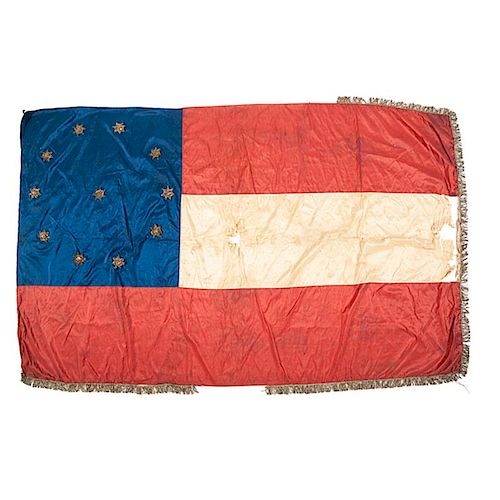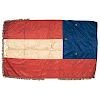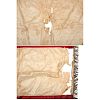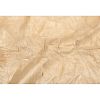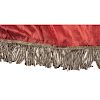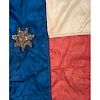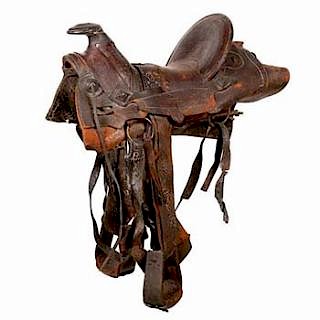Confederate First National Flag Captured New Orleans by Captain Edward W. Thompson, 1st Maine Light Artillery, Battery A
About Seller
6270 Este Ave.
Cincinnati , OH 45232
United States
With offices in Cincinnati, Cleveland and Denver, Cowan’s holds over 40 auctions each year, with annual sales exceeding $16M. We reach buyers around the globe, and take pride in our reputation for integrity, customer service and great results. A full-service house, Cowan’s Auctions specializes in Am...Read more
Two ways to bid:
- Leave a max absentee bid and the platform will bid on your behalf up to your maximum bid during the live auction.
- Bid live during the auction and your bids will be submitted real-time to the auctioneer.
Bid Increments
| Price | Bid Increment |
|---|---|
| $0 | $25 |
| $500 | $50 |
| $1,000 | $100 |
| $2,000 | $250 |
| $5,000 | $500 |
| $10,000 | $1,000 |
| $20,000 | $2,500 |
| $50,000 | $5,000 |
| $100,000 | $10,000 |
About Auction
Nov 1, 2016 - Nov 3, 2016
Cowan's Auctions dawnie@cowans.com
- Lot Description
Edward W. Thompson enlisted on June 24, 1861 as the captain of Co. D, 5th Maine Infantry. As such he would have seen his initial combat at First Manassas (Bull Run) on July 21st, 1861. The regiment then moved back into the defenses of Washington City, and Thompson resigned his commission on September 8, 1861. On October 5, 1861, he reenlisted as the captain and commander of the 1st Maine Light Artillery Battalion, Battery A. He would remain in this battery until resignation for ill health on December 5, 1862.
After recovery, he reentered the service, this time as captain of Co. G, 12th Maine Infantry. That regiment had served in New Orleans along with his Maine battery and sometimes worked together as part of the same brigade. As such, Thompson probably knew officers of the unit and it was thus easy for him to join the regiment on March 1, 1863. The regiment served in Louisiana until 1864 fighting in several places including Port Hudson, before being transferred to Virginia later in the year where they ended their wartime career in April, 1865. Thompson remained in the service until March 6, 1866.
On February 28th, 1865, he married Maria Louise Le Prohon, daughter of the Vice Consul of France to the State of Maine. After the war, Thompson became involved in Maine politics (as he was during the war) and veterans organizations. He was a regular participant in reunions of the 12th Maine Infantry, where he was often a keynote speaker.
According to the Portland Daily Press of June 19, 1874, Thompson had been serving in the Reconstruction administration of Governor Elisha Baxter. Baxter was the focus of the very controversial election that split the two Republican candidates which devolved into armed conflict with some 200 men getting killed and wounded before President Ulysses S. Grant stepped in and placed Baxter back in office. According to this article, "Edward W. Thompson, of this state, chief of staff of Governor Baxter, has assumed command of the northeast division of Arkansas as a Major General." It is not known how Thompson became involved with Baxter who only lasted into late 1874 as Arkansas' governor.
At some point after this, Thompson returned to Maine, and died there sometime before November, 1881.
Thompson and the 1st Maine Light Artillery, Battery A
While Thompson served much longer in the 12th Maine Infantry during the Civil War, it was his service with this battery that pertains to the flag in question.
The battery was organized in Portland, Maine and was mustered into service on December 18, 1861. After a period of training in Massachusetts, the battery took a steamship to Ship Island in the Gulf of Mexico off the coast of Mississippi, arriving in March 1862. After New Orleans was captured by on April 25th, 1862, Union troops under General Benjamin Butler moved into the city in force. New Orleans would remain in Federal control for the rest of the war.
Subduing the hostile population was one duty performed by Butler's men, and Thompson's battery was part of an incident mentioned in Butler's post-war memoirs. When a New Orleans resident tore down a U.S. flag, a near riot broke out when Butler ordered the southerner to be tried and hanged for his deed. As an angry crowd grew at Butler's headquarters and demanded his appearance, attention soon turned to a loud noise coming down St. Charles Street. It was Thompson and the six guns of his battery in full charge riding to rescue their commander. As Butler noted in his memoir, "Thompson was one of the most dare-devil furious riders I ever saw, and he was leading his battery down the street as if there were nobody in it, every horse driven at the fullest speed and the bugles sounding the charge." Thompson placed his guns into battery and was ready to sweep the streets nearby with their fire before the crowd gave up and dispersed.
A section of the battery also was part of Union expeditions into areas near New Orleans designed to hold bridges, railroad stations and other crucial areas in addition to driving off any Confederate forces in the region. One such action was at Bonnet Carre in September 1862 where they helped defeat the 13th Texas Cavalry Battalion. What was probably Thompson's last action took place at Labadieville, Louisiana in October where they captured a Confederate cannon.
New Orleans was surrounded by swamps and bayous and mosquito infested; malaria was a constant problem for the Federal garrison with hundreds of men falling ill. One of these was Thompson, and he was forced to resign his commission in the battery on December 5, 1862. He then returned to Maine to recuperate.
How Thompson Obtained the Flag
When Butler took control of New Orleans, on May 1st he issued a proclamation to the citizens in order to establish law and order. This proclamation ordered the surrender of all arms, citizenry establishing an oath of allegiance to the United States, and the following provision included: "All flags, ensigns, and devices, tending to uphold any authority whatever, save the flag of the United States and the flags for foreign consulates, must not be exhibited, but suppressed. The American ensign, the emblem of the United States, must be treated with the utmost deference and respect by all persons, under pain of severe punishment."
With this edict came the hunt for all Confederate flags in the city, and Thompson was in the right place at the right time. Nothing in the provenance retained by Thompson's present descendants, however, provided many clues as to the complete history of the flag. Thankfully, research into several Maine and other newspapers revealed when and where Thompson captured the flag.
The Portland (Maine) Daily Express ran an article in its November 8, 1881 edition indicating "The Advertiser says that Mrs. Maria Louise Thompson, of this city, has a Confederate battle flag which was captured in the war by her husband, now deceased, who was captain of the First Maine Light Artillery. This flag was made and presented by the ladies of New Orleans to a regiment or company composed of the first young men of the city. It is quite large, is made of silk, with silver fringe, and with stars and bars in the middle, and bears the letters B.H.G."
This article describes the flag precisely, and conclusively proves that it was taken in New Orleans. Some of the above is hyperbole, however. Since the flag displays eleven stars it could not have been issued to "the first young men of that city" to fight in the War. Still, this is a crucial piece of evidence as to where the flag was made and where Thompson got it.
The rest of the article suggests that Mrs. Thompson was seeking to find out what unit it belonged to as she was intent on returning the flag to them. "Mrs. Thompson desires to ascertain the number or name of the regiment or company to which the banner belonged in order that it may be returned to its former gallant owners as an act of courtesy on the part of the Maine officers of the Grand Army of the Republic." The article indicates the complete story of the capture of the flag was not passed along by Thompson to his descendants. After his death in 1881, this important bit of provenance was lost.
Interestingly Thompson's widow's attempt at repatriation predates the first efforts by U.S. War Department leadership to return the hundreds of captured Confederate flags back to the Southern states. This took place in 1887 under the administration of President Grover Cleveland. When it was announced, the Grand Army of the Republic and its membership, thousands upon thousands of Union veterans, went apoplectic with rage and the newspapers were filled with condemnation of the plan for months. The fact that Mrs. Thompson had the backing of the Maine G.A.R. is remarkable for the time. It was not until 1905 that these flags would be returned.
Further newspaper research shows this same article ran in other newspapers in New England including others in Maine as well as in Boston. The key newspaper, however, was the New Orleans Times Picayune, where the story ran on November 13, 1881. Evidently her efforts failed, for the flag remained in the Thompson family until recently.
History of the First National colors of the Confederacy and Description of the Thompson Flag
The First National flag came into existence on March 4, 1861 complying with orders from the Committee on Flag and Seal of the Provisional Confederate Congress in Montgomery, Alabama. The first example was hoisted above the Alabama state capitol later that afternoon. Within 24 hours, news of the new flag spread throughout the Confederacy.
The first examples bore only seven stars for this was how many states had seceded by this time. After the firing on Fort Sumter on April 12, 1861, four more states left the Union with Tennessee being the last in early June 1861. As more states left, more stars were added. Missouri was recognized in September and Kentucky in November bringing the flag up to thirteen stars. Examples of this flag exist bearing a single star to seventeen stars with the most common examples being seven, eleven and thirteen stars.
Besides being the first political flag of the Confederacy, it also became the first battle flag for both the Confederate Army and Confederate Navy. Large versions of the flag flew over government buildings and forts, posts and garrisons as well as warships of the navy. Despite being replaced by other battle flag designs, the First National served through the end of the Civil War.
The Thompson flag bears eleven silver bullion stars on the obverse side; only three remain on the reverse although the stitching that held them to the canton remains for the other eight. The star count indicates a probable June through September 1861 time frame for its manufacture.
The outer edges are trimmed with silver metallic fringe which is intact on the fly end and most of the upper edge. The bullion fringe and stars would have been expensive accessories in 1861. As noted below, these trappings may have been purchased from the establishment of B. Piffet, the dry goods dealer who sold special trimmings for flags.
The silk used for the canton and three bars is a thin dress silk which was probably purchased at a local dry goods store. Bulk silk was sold in bolts that were typically eighteen inches wide. Silk was quite easy to secure in Confederate cities until the Union Navy blockade clamped down later in the war.
Physical Description
Hoist and fly – 48 inches by 80 inches. The outer edges are folded over and sewn with a single line of stitches measuring 1/14 inches. The fringe is sewn over this.
Canton – 33.25 inches high by 30.25 inches wide. This is constructed of two pieces of blue silk sewn together with flat fell seams with a double line of stitches through its center. The canton is sewn to the three color bars in the same manner.
Fringe – silver metallic, 1.75 inches wide. This is hand-sewn to the outer edge if the flag. Along the bottom edge is a thick string tied to some of the fringe that measures 4.5 inches long. This probably indicates that the flag was at some point hung on Thompson's wall for display. No doubt similar ties to the fringe would have been on the upper edge and the other side of the lower edge.
Bars – The upper red bar is 17 inches wide; the center white bar is 17 inches wide and the lower red bar is 16.75 inches wide. These are sewn to each other with flat fell seams with a double line of stitches.
Stars – Silver embroidered bullion, 2.75 inches across. The stars are sewn to the flag.
Hoist edge – The silk is folded over and sewn with a single line of stitches. There are two ties at the top and bottom end; a thick string tied onto the flag by wrapping around a bit of the corners to create an attachment to the flag staff. The hoist edge measures 6 /8 inches.
Letters BHG appearing on white bar – 2.5 inches tall. These are not complete and only consist of the ink markers by the flag maker or artist hired to paint the flag. These dots are then connected with pencil which shapes the letters into curved and ornate letters rather than block lettering.
This flag is entirely machine sewn with the exception of the stars to the canton and the fringe to the outer edges. The thread used for most of the flag appears to be silk while cotton thread appears to have been used for the outer edges in attaching the fringe.
The Letters "B H G"
In the over 27 years that I have been examining Confederate flags I have seen numerous flags bearing painted and embroidered unit designations, stars, patriotic slogans and battle honors. In all of this time I have never seen a flag that had an incomplete set of lettering before. As mentioned, these letters have been blocked by the maker or artist with inked dots which were then lined off by pencil to shape the letters into a more ornate template. Also somewhat unique is that these letters are not that large and they indicate either the unit commander or are the initials of the unit nickname, probably a company of local troops.
An examination of the book on Louisiana units written by the late historian Arthur W. Bergeron Jr., did not find any units with the initials "BHG" nor any officer with a name with those letters. The only Confederate companies that were located with these letters were the Ben Hill Guards of the 38th Georgia Infantry and the Buchanan Home Guards of Virginia; neither served in Louisiana.
Due to the incomplete nature of the letters, it is this researcher's opinion that this flag was probably never issued to its intended unit. This makes it very similar to the flag of the Leeds Guards already mentioned. A large number of flags were taken in New Orleans when Butler's troops arrived, most of them disappearing over time. While many units received flags after formation or while in training camp, other flags were not presented until after units had shipped out to the front. Thus, it can be reasoned that some of the flags found by Butler's men were probably also incomplete.
New Orleans Flag Makers at the Outbreak of the Civil War: The Likely Maker of the Thompson Flag
By the beginning of the War, New Orleans was well equipped for making flags. The 1861 City Directory lists 57 dry goods dealers; 19 sign painters and 8 sewing machine dealers (including agents for Singer and Grover & Baker). As demand for the new colors of the Confederacy grew, many of these trades began making both regimental and patriotic flags as well as larger banners for use over ships and forts.
Known New Orleans flag makers include sign painters like Toby Hart, who often fashioned unit designations and patriotic slogans on flags. Others known to have made flags include businesses and individuals like William Bell, William Weber, Nettie Green, Deter's Worsted Store, James Titus and Stauffer & Eishleman & Company, the latter making embroidered flags. B. Piffet offered, "gold and silver tassels, crods and trimmings for flags," while Robert Anderson offered flag spears. Flag makers for the Signal Corps and Confederate Navy include Alfred Barbot, Henry Cassidy (who also made numerous army unit flags), William Noble, Spearing & Company and Mary Titus.
The second type of flags made were the larger banners needed for ships, forts, garrisons and posts, of which the New Orleans area had many. The tradesmen that made these flags were typically ship chandlers and sail makers, both of which were used to working with large sizes of cloth and thus had the skills and equipment to make larger flags. New Orleans had twenty of these firms in 1861. Known New Orleans flag makers include sail maker Charles Royal, Arthur Hauch and Patrick McGuigin.
New Orleans' several newspapers carried advertisements for making flags after the secession of the state. Most of the aforementioned flag makers did so. One of these was Mrs. A. E. Ober of No. 11 Camp Street whose first ads beginning in May 1861 touting, "Confederate flags made of silk, complete with staff, spears, etc. always on hand. Also flags of all kinds made to order and sale." The City Directory lists Ober as 35 years old and a seamstress.
In the same month a number of appear for Grover & Baker's Sewing Machine office, also located at No. 11 Camp Street. One ad states, "Confederate Flags made of Silk, Gold Fringe, Silver Stars, all complete, for sale at Grover & Baker's Sewing Machine office." Apparently Ober not only made flags, but was also an agent for Grover and Baker, and would have used their sewing machine to construct flags.
The 1861 City Directory also lists a "W. L. Cushing" as proprietor of the Grover & Baker Sewing Machine Company listed at No. 57 St. Charles Street. By October 1861, Cushing advertised, "red silk for flags" in newspapers, with his office at No. 11 Camp Street – the same as Ober's.
Based upon this research, it seems plausible that Mrs. A. E. Ober made the First National offered here, sewing it on her Grover and Baker machine.
Comparisons To Other Ornate Louisiana Unit Colors
This flag can be compared to some other existing Louisiana silk First National unit flags in terms of style such as embroidered stars, bullion stars and fringe exterior sides. Examples include:
Leeds Guards – silk embroidered stars with metallic fringe outer edges
5th Louisiana Battalion – silver bullion stars and metallic fringe outer edges
Washington Artillery Battalion of New Orleans – silver bullion stars with metallic fringe
1st Louisiana Special Battalion (Wheat's) – silk stars with embroidered edges and metallic fringe
6th Louisiana Infantry, Co. D, Tensas Rifles - silk stars with metallic braid and metallic fringe
30th Louisiana Infantry, Co. A, Algiers Guards – silk embroidered stars with metallic fringe
7th Louisiana Infantry – gold bullion stars with metallic fringe
8th Louisiana Infantry, Co. B, Bienville Rifles – silk with embroidered edges and metallic fringe
11th Louisiana Infantry – silver wire embroidered stars with metallic fringe
Crescent City Battery Louisiana Artillery - metallic embroidered stars with metallic fringe
Gregory G. Biggs
Military Historian
September 16, 2015
References Cited
Books
Amann, William, Personnel of the Civil War (Thomas Yoselof, New York, 1961)
Bartlett, Napier, Military Record of Louisiana (Louisiana State University Press, Baton Rouge, 1964)
Bergeron, Arthur W., Jr, Guide To Louisiana Confederate Military Units 1861-1865 (Louisiana State University Press, Baton Rouge, 1989)
Black, Robert C., The Railroads of the Confederacy (Broadfoot Publishing, Wilmington, 1987)
Butler, Benjamin, Butler's Book: A Review of his Legal, Political and Military Career (A.M. Thayer Publishers, Boston, 1892)
Dyer, Frederick H., A Compendium of the War of the Rebellion (Morningside Bookshop, Dayton, 1979, reprint)
Evans, Gen. Clement A., editor, Louisiana and Arkansas: Confederate Military History (The Blue & Gray press, Secaucus, n.d)
Frazier, Donald S., Fire in the Canefield: The Federal Invasion of Louisiana and Texas, January 1861-January 1863 (State House Press, Buffalo Gap, 2009)
Nolan, Dick, Benjamin Franklin Butler: The Damnedest Yankee (Presidio Press, Novato, 1991)
Tancig, W. J., Confederate Military Land Units 1861-1865 (Thomas Yoselof, New York, 1967)
Whitman, William E.S. and True, Charles H., Maine in the War for the Union: A History of the Part Borne by Maine Troops (Nelson Dingley Jr. & Co. Publishers, Lewiston, 1865)
Winters, John D., The Civil War in Louisiana (Louisiana State University Press, Baton Rouge, 1963)
Other Sources
Official Army Registers of the Volunteer Force of the United States Army – The Years 1861-1865, Part One - New England States (Adjutant General's Office, Washington DC, 1865)
Official Records of the Union and Confederate Armies in the War of the Rebellion (Government Printing Office, 1894)
Greg Biggs Flag Files
Howard Michael Madaus Papers, U.S. Army Heritage and Education Center, Carlisle, PA
Newspapers
New Orleans Times-Picayune
Portland (ME) Daily Eastern Argus
Portland (ME) Daily Express
Bangor (ME) Daily Whig and Courier - Shipping Info
-
SHIPPING. At the request of the buyer, Cowan's will authorize the shipment of purchased items. Shipments usually occur within two weeks after payment has been received. Shipment is generally made via UPS Ground service. Unless buyer gives special instructions, the shipping method shall be at the sole discretion of Cowan's Auctions, Inc.. Cowan's is in no way responsible for the acts or omissions of independent handlers, packers or shippers of purchased items or for any loss, damage or delay from the packing or shipping of any property.
If you are purchasing a firearm that requires an FFL or C&R and you do not have one, we can transfer the gun to a firearms dealer of your choice. We will transfer and ship the firearm to them, and they will then transfer it to you. Any charges for this service (which may include a background check) are between you and the dealer. If you come to Cowan’s in person to pick up your purchase(s), we can transfer a long gun to you directly. Handguns can only be transferred to Ohio residents.
-
- Buyer's Premium



 EUR
EUR CAD
CAD AUD
AUD GBP
GBP MXN
MXN HKD
HKD CNY
CNY MYR
MYR SEK
SEK SGD
SGD CHF
CHF THB
THB